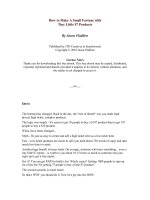THE TIPPING POINT How Little Things Can Make a Big Difference docx
Bạn đang xem bản rút gọn của tài liệu. Xem và tải ngay bản đầy đủ của tài liệu tại đây (1.54 MB, 653 trang )
TH E TIPPING POINT
How Little Things Can Make a
Big Difference MALCOLM
GLADWELL
LITTLE, BROWN AND COMPANY
BOSTO N • NEW YORK • LONDON
Copyright © 2000 by Malcolm Gladwell
All rights reserved. No part of this book may be
reproduced in any form or by any electronic or
mechanical means, including information storage and
retrieval systems, without permission in writing from the
publisher, except by a reviewer who may quote brief
passages in a review.
First Edition
The author is grateful for permission to include the
following previously copyrighted material: Excerpts from
interviews on Market Mavens videotape by Linda Price,
Lawrence F. Feick, and Audrey Guskey. Reprinted by
permission of the authors.
Exerpts from Daniel Wegner, "Transactive Memory:
A Contemporary Analysis of the Group Mind." Journal
of Personality and Social Psychology (1991), vol. 61,
no. 6. Reprinted by permission of the author.
Exerpts from Donald H. Rubinstein, "Love and
Suffering: Adolescent Social ization and Suicide in
Micronesia," Contemporary Pacific (Spring 1995), vol.
7, no. l, and "Epidemic Suicide Among Micronesian
Adolescents." Social Science and Medicine (1983).
vol. 17. Reprinted by permission of the author.
Excerpts from Paul Revere's Ride by David Hackett
Fischer. Copyright © 1994
by Oxford University Press. Reprinted by permission of
the publisher.
Library of Congress Cataloging-in-Publication Data
Gladwell Malcolm. The tipping point: how little things can
make a big difference / by Malcolm Gladwell. p. cm.
Includes index. ISBN0-316-31696-2 1. Social
psychology, 2. Contagion (Social psychology) 3.
Causation. 4. Context effects (Psychology) I. Title.
HM1033.G53 2000 302 dc21 99-047576 1 0 98765432 1
Design: Meryl Sussman Levavi/Digitext, Inc.
Printed in the United States of America
To my parents,
Joyce and Graham Gladwell
Contents
Introduction 3
ONE
The Three Rules of Epidemics 15
T W O The Law of the Few:
Connectors, Mavens, and Salesmen 30
T H R E E The Stickiness Factor:
Sesame Street, Blue's Clues, and the
Educational Virus 89
VIII TH F TIPPING POINT
FOUR The Power of Context (Part
One): Bernie Goetz and the Rise and Fall
of New York City Crime 133
F I VE The Power of Context (Part
Two): The Magic Number One Hundred
and Fifty 169
S I X Case Study: Rumors, Sneakers,
and the Power of Translation 193
SEVEN
Case Study: Suicide, Smoking, and the
Search for the Unsticky Cigarette 216
EIGHT Conclusion: Focus, Test, and
Believe 253
Endnotes 260 Acknowledgments 271
Index 273
TH E TIPPIN G
POINT
Introduction
F
or Hush Puppies — the classic
American brushed-suede shoes with the
lightweight crepe sole —- the Tipping
Point came somewhere between late 1994
and early 1995. The brand had been all
but dead until that point. Sales were down
to 30,000 pairs a year, mostly to
backwoods outlets and small-town family
stores. Wolverine, the company that makes
Hush Puppies, was thinking of phasing out
the shoes that made them famous. But then
something strange happened. At a fashion
shoot, two Hush Puppies executives —
Owen Baxter and Geoffrey Lewis — ran
into a stylist from New York who told
them that the classic Hush Puppies had
suddenly become hip in the clubs and bars
of downtown Manhattan. "We were being
told," Baxter recalls, "that there were
resale shops in the Village, in Soho,
where the shoes were being sold. People
were going to the Ma and Pa stores, the
little stores that still carried them, and
buying them up." Baxter and Lewis were
baffled at first. It made no sense to them
that shoes that were so obviously out of
fashion could make a comeback. "We
were told that Isaac Mizrahi was wearing
the shoes himself," Lewis says. "I think it's
fair to say thai at the time we had no idea
who Isaac Mizrahi was."
By the fall of 1995, things began to
happen in a rush. first the designer John
Bartlctt called. He wanted to use I lush
Puppies in his spring collection. Then
another Man hattan designer, Anna Sui,
called, wanting shoes for her show as
well. In Los Angeles, the designer Joel
Fitzgerald put a twenty-five-foot inflatable
basset hound — the symbol of the Hush
Puppies brand — on the roof of his
Hollywood store and gutted an adjoining
art gallery to turn it into a Hush Puppies
boutique. While he was still painting and
putting up shelves, the actor Pee-wee
Herman walked in and asked for a couple
of pairs. "It was total word of mouth,"
Fitzgerald remembers.
In 1995, the company sold 450,000
pairs of the classic Hush Puppies, and the
next year it sold lour times that, and the
year after that still more, until Hush
Puppies were once again a staple of the
wardrobe of the young American male. In
1996, Hush Puppies won the prize for best
accessory at the Council of Fashion
Designers awards dinner at Lincoln
Center, and the president of the firm stood
up On the stage with Calvin Klein and
Donna Karan and accepted an award for
an achievement that — as he would be the
first to admit — his company had almost
nothing to do with. Hush Puppies had
suddenly exploded, and it all started with
a handful of kids in the East Village and
Soho.
How did that happen? Those first few
kids, whoever they were, weren't
deliberately trying to promote Hush
Puppies. They were wearing them
precisely because no one else would wear
them. Then the fad spread to two fashion
designers who used the shoes to peddle
something else — haute couture. The
shoes were an incidental touch. No one
was trying to make Hush Puppies a trend.
Yet, somehow, that's exactly what
happened. The shoes passed a certain
point in popularity and they tipped. How
docs a thirty-dollar pair of shoes go from
a handful of downtown Manhattan hipsters
and designers to every mall in America in
the space of two years?
1.
There was a time, not very long ago,
in the desperately poor New York City
neighborhoods of Brownsville and East
New York, when the streets would turn
into ghost towns at dusk. Ordinary
working people wouldn't walk on the
sidewalks. Children wouldn't ride their
bicycles on the streets. Old folks wouldn't
sit on stoops and park benches. The drug
trade ran so rampant and gang warfare
was so ubiquitous in that part of Brooklyn
that most people would take to the safety
of their apartment at nightfall. Police
officers who served in Brownsville in the
1980s and early 1990s say that, in those
years, as soon as the sun went down their
radios exploded with chatter between beat
officers and their dispatchers over every
conceivable kind of violent and dangerous
crime. In 1992, there were 2,154 murders
in New York City and 626,182 serious
crimes, with the weight of those crimes
falling hardest in places like Brownsville
and Hast New York. But then something
strange happened. At some mysterious and
critical point. the crime rate began to turn.
It tipped. Within five' years, murders had
dropped 64.3 percent to 770 and total
crimes had fallen by almost half to
355,893. In Brownsville and East New
York, the sidewalks filled up again, the
bicycles came back, and old folks
reappeared on the stoops. "There was a
time when it wasn't uncommon to hear
rapid tire, like you would hear somewhere
in the jungle in Vietnam," says Inspector
Edward Messadri, who commands the
police precinct in Brownsville. "I don't
hear the gunfire anymore."
The New York City police will tell
you that what happened in New York was
that the city's policing strategies
dramatically improved. Criminologists
point to the decline of the crack trade and
the aging of the population. Economists,
meanwhile, say that the gradual
improvement in the city's economy over
the course of the 1990s had the effect of
employing those who might otherwise
have become criminals. These are the
conventional expla nations for the rise and
fall of social problems, but in the end
none is any more satisfying than the
statement that kids in the East Village
caused the Hush Puppies revival. The
changes in the drug trade, the population,
and the economy are all long-term trends,
happening all Over the country. They don't
explain why crime plunged in New York
City so much more than in other cities
around the country, and they don't explain
why it all happened in such an
extraordinarily short time. As for the
improvements made by the police, they
are important too. But there is a puzzling
gap between the scale of the changes in
policing and the size of the effect on
places like Brownsville and East New
York. After all, crime didn't just slowly
ebb in New York as conditions gradually
improved. It plummeted. How can a
change in a handful of economic and
social indices cause murder rates to fall
by two-thirds in five years?
2.
The Tipping Point is the biography of
an idea, and the idea is very simple. It is
that the best way to understand the
emergence of fashion trends, the ebb and
How of crime waves, or, for that matter,
the transformation ot unknown books into
bestsellers, or the rise of teenage smoking,
or the phenomena of word of mouth, or
any number of the other mysterious
changes that mark everyday life is to think
of them as epidemics. Ideas and products
and messages and behaviors spread just
like viruses do.
The rise of Hush Puppies and the fall
of New York's crime rate are textbook
examples of epidemics in action. Although
they may sound as if they don't have very
much in common, they share a basic,
underlying pattern. First of all, they are
clear examples of contagious behavior.
No one took out an advertisement and told
people that the traditional Hush Puppies
were cool and they should start wear ing
them. Those kids simply wore the shoes
when they went to clubs or cafes or
walked the streets of downtown New
York, and in so doing exposed other
people to their fashion sense. They
infected them with the Hush Puppies
"virus."
The crime decline in New York surely
happened the same way. It wasn't that
some huge percentage ol wouldbe
murderers suddenly sat up in 1993 and
decided not to commit any more crimes.
Nor was it that the police managed
magically to intervene in a huge
percentage of situations that would
otherwise have turned deadly. What
happened is that the small number of
people in the small number of situations in
which the police or the new social forces
had some impact started behaving very
differently, and thai behavior somehow
spread to other would-be criminals in
similar situations. Somehow a large
number ol people in New York got
"infected" with an anti-crime virus in a
short, time.
The second distinguishing
characteristic of these two examples is
that in both cases little changes had big
clfccts. All of the possible reasons for
why New York's crime rate dropped are
changes that happened at the margin; they
were incremental changes. The crack
trade leveled off. The population got a
little older. The police force got a little
better. Yet the effect was dramatic. So too
with Hush Puppies. How many kids are
we talking about who began wearing the
shoes in downtown Manhattan? Twenty?
Fifty? One hundred — at the most? Yet
their actions seem to have single-handedly
started an international fashion trend.
Finally, both changes happened in a
hurry. They didn't build steadily and
slowly. It is instructive to look at a chart
of the crime rate in New York City from,
say, the mid1960s to the late 1990s. It
looks like a giant arch. In 1965, there
were 200,000 crimes in the city and Irom
that point on the number begins a sharp
rise, doubling in two years and continuing
almost unbroken until it hits 650,000
crimes a year in the mid-1970s. It stays
steady at that level for the next two
decades, before plunging downward in
1992 as sharply as it rose thirty years
earlier. Crime did not taper off. It didn't
gently decelerate. It hit a certain point and
jammed on the brakes.
These three characteristics — one,
contagiousness; two, the fact that little
causes can have big effects; and three, that
change happens not gradually but at one
dramatic moment — are the same three
principles that define how measles moves
through a grade-school classroom or the
flu attacks every winter. Of the three, the
third trait — the idea that epidemics can
rise or fall in one dramatic moment — is
the most important, because it is the
principle that makes sense of the first two
and that permits the greatest insight into
why modern change happens the way it
does. The name given to that one dramatic
moment in an epidemic when everything
can change all at once is the Tipping
Point.
3.
A world that follows the rules of
epidemics is a very dif ferent place from
the world we think we live in now. Think,
for a moment, about the concept of
contagiousness. If I say that word to you,
you think of colds and the flu or perhaps
something very dangerous like HIV or
Ebola. We have, in our minds, a very
specific, biological notion of what
contagiousness means. But if there can be
epidemics of crime or epidemics of
fashion, there must be all kinds of things
just as contagious as viruses. Have you
ever thought about yawning, for instance?
Yawning is a surprisingly powerful act.
Just because you read the word "yawning"
in the previous two sentences — and the
two additional "yawns" in this sentence —
a good number of you will probably yawn
within the next few minutes. Even as I'm
writing this, I've yawned twice. If you're
reading this in a public place, and you've
just yawned, chances are that a good
proportion of everyone who saw you
yawn is now yawning too, and a good
proportion of the people watching the
people who watched you yawn are now
yawning as well, and on and on, in an
ever-widening, yawning circle.
Yawning is incredibly contagious. I
made some of you reading this yawn
simply by writing the word "yawn." The
people who yawned when they saw you
yawn, meanwhile, were infected by the
sight of you yawning — which is a second
kind of contagion. They might even have
yawned if they only heard you yawn,
because yawning is also aurally
contagious: if you play an audiotape of a
yawn to blind people, they'll yawn too.
And finally, if you yawned as you read
this, did the thought cross your mind —
however unconsciously and fleetingly —
that you might be tired? I suspect that for
some of you it did, which means that
yawns can also be emotionally contagious.
Simply by writing the word, I can plant a
feeling in your mind. Can the flu virus do
that? Contagiousness, in other words, is an
unexpected property of all kinds of things,
and we have to remember that, if we are
to recognize and diagnose epidemic
change.
The second of the principles of
epidemics — that little changes can
somehow have big effects — is also a
fairly radical notion. We are, as humans,









